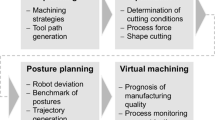Abstract
Current industrial robotic welding systems cannot achieve automated solutions for multi-layer multi-pass welding of complex joints due to the presence of non-uniform and irregular welding groove geometries. This paper presents an adaptive pass planning approach for robotic welding of such complex joints. The welding groove is first segmented considering both the variation in groove dimension and the reachability of the robot welding torch. For each welding segment, the welding passes are planned to be in accordance with welding practices, viz., keeping the same number of welding passes in each layer while maintaining consistent welding parameters. An adaptive pass adjustment scheme is developed to address the discrepancies between the simulated results and the actual welding deposition after finishing a few layers of welding. Corresponding robot paths are generated and optimized to ensure minimum joint movement subject to three constraints, viz., reachability, collision-free and singularity avoidance. The proposed approach has been simulated with the arc welding of a Y-type joint found typically in offshore structures.











Similar content being viewed by others
References
Lorincz J (2015) Robotic welding fills skills gap with quality production. http://www.sme.org/MEMagazine/Article.aspx?id=8589936441. Accessed 26 Oct 2015
Lin W, Luo H (2015) Robotic welding. In: Nee AYC (ed) Springer handbook of manufacturing engineering and technology: robotics and automation. Springer, London, pp 2404–2444
Pires JN, Loureiro A, Bölmsjo G (2006) Welding robots: technology, system issues and application. Springer, London
Neto P, Mendes N (2013) Direct off-line robot programming via a common CAD package. Robot Auton Syst 61(8):896–910
Reinhart G, Munzert U, Vogl W (2008) A programming system for robot-based remote-laser-welding with conventional optics. Annals of the CIRP 57(1):37–40
Fang HC, Ong SK, Nee AYC (2012) Interactive robot trajectory planning and simulation using augmented reality. Robot Comput Integr Manuf 28(2):227–237
Fang HC, Ong SK, Nee AYC (2014) Novel AR-based interface for human-robot interaction and visualization. Adv Manuf 2(4):275–288
Yang C, Ye Z, Chen Y et al (2014) Multi-pass path planning for thick plate by DSAW based on vision sensor. Sensor Rev 34(4):416–423
Cao Y, Zhu S, Liang X et al (2011) Overlapping model of beads and curve fitting of bead section for rapid manufacturing by robotic MAG welding process. Robot Comput Integr Manuf 27(3):641–645
Xiong J, Zhang G, Gao H et al (2013) Modeling of bead section profile and overlapping beads with experimental validation for robotic GMAW-based rapid manufacturing. Robot Comput Integr Manuf 29(2):417–423
Suryakumar S, Karunakaran KP, Bernard A et al (2011) Weld bead modeling and process optimization in hybrid layered manufacturing. Comput Aided Design 43(4):331–344
Ganjigatti JP, Pratihar DK, Choudhury R (2007) Global versus cluster-wise regression analyses for prediction of bead geometry in MIG welding process. J Mater Process Tech 189:352–366
Lee JI, Um KW (2000) Prediction of welding process parameters by prediction of back-bead geometry. J Mater Process Tech 108:106–113
Kim I, Son J, Park C et al (2002) A study on prediction of bead height in robotic arc welding using a neural network. J Mater Process Tech 130–131:229–234
Nagesh DS, Datta GL (2002) Prediction of weld bead geometry and penetration in shielded metal-arc welding using artificial neural networks. J Mater Process Technol 123:303–312
Yan SJ, Ong SK, Nee AYC (2016) Optimal pass planning for robotic welding of large-dimension joints with deep grooves. In: Proceedings of 9th international conference on digital enterprise technology (det2016)—intelligent manufacturing in the knowledge economy era, 29–31 March 2016, Nanjing, China
Huo L, Baron L (2008) The joint-limits and singularity avoidance in robotic welding. Ind Robot 35(5):456–464
Huo L, Baron L (2011) The self-adaptation of weights for joint-limits and singularity avoidances of functionally redundant robotic-task. Robot Comput Integr Manuf 27(2):367–376
Ogbemhe J, Mpofu K (2015) Towards achieving a fully intelligent robotic arc welding: a review. Ind Robot 42(5):475–484
Fang HC, Ong SK, Nee AYC (2016) Robot path planning optimization for welding complex joints. Int J Adv Manuf Technol. doi: 10.1007/s00170-016-9684-z
Rampaul H (2002) Pipe welding procedure, 2nd edn. Industrial Press, New York
Acknowledgements
This research is supported by the Singapore A*STAR Agency for Science, Technology and SERC Industrial Robotic Programme on Robotic Welding of Complex Joint (Grant No. 1225100006).
Author information
Authors and Affiliations
Corresponding author
Rights and permissions
About this article
Cite this article
Fang, H.C., Ong, S.K. & Nee, A.Y.C. Adaptive pass planning and optimization for robotic welding of complex joints. Adv. Manuf. 5, 93–104 (2017). https://doi.org/10.1007/s40436-017-0181-x
Received:
Accepted:
Published:
Issue Date:
DOI: https://doi.org/10.1007/s40436-017-0181-x




